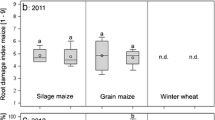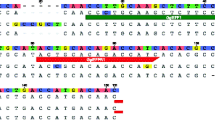Abstract
Through a combination of controlled environment experiments and the monitoring of commercial potato crops, the relative importance of seed- and soil-borne inoculum of Rhizoctonia solani AG-3 in causing black scurf on potato tubers was investigated. Seed- and soil-borne inoculum of R. solani was quantified using an existing real-time PCR assay and related to subsequent incidence and severity of disease. In a controlled environment experiment, in the absence of soil inoculum, planting seed with >10% black scurf resulted in significantly (P < 0.05) higher incidence of black scurf on progeny tubers (93%) than planting seed with less severe symptoms (<25%). When inoculum was added to the soil, the incidence (≥80%) and severity (c. 2 on a scale 0–5) of disease on the progeny tubers was similar to that resulting from high levels of seed inoculum. There was no additional increase in disease incidence or severity when both soil and seed inoculum were present. When 108 commercial potato crops were monitored, the health status of the commercial seed stocks planted (often chemically treated) was found to be relatively less important than soil-borne inoculum in causing black scurf. However, in 50% of the 28 crops where no inoculum was detected on either seed or in soil, some black scurf was recorded on progeny tubers; in 11% of these crops (3 out of 28), the incidence of disease was >10%. The effectiveness of real-time PCR diagnostics to predict disease risk based on the amount of detectable soil inoculum is discussed in relation to detection thresholds and variable detection in different soil types.


Similar content being viewed by others
References
Adams MJ, Hide GA, Lapwood DH (1980) Relationship between disease levels on seed tubers, on crops during growth and in stored potatoes. I. Introduction and black scurf. Potato Res 23:201–214
Atkinson D, Thornton MK, Miller JS (2010) Development of Rhizoctonia solani on stems, stolons and tubers of potatoes I. Effect of inoculum source. Am J Potato Res 87:374–381
Baker KF (1970) Types of Rhizoctonia diseases and their occurrence. In: Parmeter JR Jr (ed) Rhizoctonia solani: biology and pathology. University of California Press, Berkeley, pp 125–148
Banville GJ (1989) Yield losses and damage to potato plants caused by Rhizoctonia solani Khün. American Potato Journal 66:821–834
Banville GJ, Carling DE, Otrysko BE (1996) Rhizoctonia disease on potato. In: Sneh B, Jabaji-Hare S, Neate S, Dijst G (eds) Rhizoctonia species: taxonomy, molecular biology, ecology, pathology and disease control. Kluwer Academic Publishers, Dordrecht, Netherlands, pp 321–330
Brenchley GH, Wilcox HJ (1979) Potato diseases. HMSO, London, p 106
Brierley JL, Stewart JA, Lees AK (2009) Quantifying potato pathogen DNA in soil. Appl Soil Ecol 41:234–238
Brierley JL, Sullivan L, Wale SJ, Hilton AJ, Kiezebrink DT, Lees AK (2013) Relationship between S. subterranea soil inoculum level, host resistance and powdery scab on potato tubers in the field. Plant Pathol 62:413–420
Campion C, Chatot C, Perraton B, Adndrivon D (2003) Anastomosis groups, pathogenicity and sensitivity to fungicides of Rhizoctonia solani isolates collected on potato crops in France. Eur J Plant Pathol 109:983–992
Carling DE, Leiner RH (1990) Effect of temperature on virulence of Rhizoctonia solani and other Rhizoctonia on potato. Phytopathology 80:931–934
Carling DE, Leiner RH, Westphale PC (1989) Symptoms, signs and yield reduction associated with Rhizoctonia disease of potato induced by tuber-borne inoculum of Rhizoctonia solani AG-3. American Potato Journal 66:693–701
Carling DE, Baird RE, Gitaitis RD, Brainard KA, Kuninaga S (2002) Characterization of AG-13, a newly reported anastomosis group of Rhizoctonia solani. Phytopathology 92:893–899
Cubeta MA, Vilaglys R (1997) Population biology of the Rhizoctonia solani complex. Phytopathology 87:480–484
Cullen DW, Lees AK, Toth IK, Duncan JM (2001) Conventional PCR and real-time quantitative PCR detection of Helminthosporium solani in soil and on potato tubers. Eur J Plant Pathol 107:387–98
Fiers M, Chatot C, Edel-Hermann V, Le Hingrat Y, Yanougo AK, Gautheron N, Guillery E, Alabouvette C, Steinberg C (2010) Diversity of microorganisms associated with atypical superficial blemishes of potato tubers and pathogenicity assessment. Eur J Plant Pathol 128:353–371
Frank JA, Leach SS (1980) Comparison of tuberborne and soilborne inoculum in the Rhizoctonia disease of potato. Phytopathology 70:51–53
Gilligan CA, Simons SA, Hide GA (1996) Inoculum density and spatial pattern of Rhizoctonia solani in field plots of Solanum tubersoum: effects of cropping frequency. Plant Pathol 45:232–244
Gudmestad NC, Zink RT, Huguelet JE (1979) The effect of harvesting date and tuber-borne sclerotia on the severity of Rhizoctonia disease of potato. American Potato Journal 45:35–42
Hide GA, Cayley GR (1982) Chemical techniques for control of stem canker and black scurf (Rhizoctonia solani) disease of potatoes. Ann Appl Biol 100:105–116
Hide GA, Firmager JP (1989) Effects of soil temperature and moisture on stem canker (Rhizoctonia solani) disease of potatoes. Potato Res 32:75–80
Hide GA, Read PJ (1991) Effects of rotation length, fungicide treatment of seed tubers and nematicide on diseases and the quality of potato tubers. Ann Appl Biol 119:77–87
Hide GA, Read PJ, Sandison JP (1985) Stem canker (Rhizoctonia solani) of maincrop potatoes. II. Effects on growth and yield. Ann Appl Biol 106:423–427
Hide GA, Read PJ, Firmager JP, Hall SM (1989) Stem canker (Rhizoctonia solani) on five early and seven maincrop potato cultivars II. Effects on growth and yield. Ann Appl Biol 114:267–277
James WC, McKenzie AR (1972) The effect of tuber-borne sclerotia of Rhizoctonia solani Kuhn on the potato crop. American Potato Journal 46:296–301
Keiser A (2007) Influence of farming system, specific cultivation methods and site parameters on potato quality. DSc dissertation, Swiss Federal Institute of Technology Zurich. Diss ETH no. 17135, p 129
Kyritisis P, Wale SJ (2002) Effects of soil temperature and moisture, inoculum level and depth of planting on the development of Rhizoctonia solani on micropropagated potato seed tubers. In: Proceedings crop protection in Northern Britain, pp 305–310
Kyritsis P (2003) Epidemiology and pathogenesis of mycelial soil-borne Rhizoctonia solani AG-3 on potatoes (Solanum tuberosum). University of Aberdeen, PhD Thesis, p 268
Lees AK, Cullen DW, Sullivan L, Nicolson MJ (2002) Development of conventional and quantitative real-time PCR assays for the detection and identification of Rhizoctonia solani AG-3 in potato and soil. Plant Pathol 51:293–302
Lees AK, Brierley JL, Stewart JA, Hilton AJ, Wale SJ, Gladders P, Bradshaw NJ, Peters JC (2010) The relative importance of seed and soil-borne inoculum in causing black dot disease of potato. Plant Pathol 59:693–702
Lehtonen MJ, Ahvenniemi P, Wilson PS, German-Kinnari M, Valkonen JPT (2008) Biological diversity of Rhizoctonia solani (AG-3) in a northern potato-cultivation environment in Finland. Plant Pathol 57:141–151
Muzhinhi N, Truter M, Woodhall JW, van der Waals JE (2015) Anastomosis groups and pathogenicity of Rhizoctonia solani and binucleate Rhizoctonia from potatoes in South Africa. Plant Disease “First Look”
Ophel-Keller K, McKay A, Hartley D, Herdina CJ (2008) Development of a routine DNA-based testing service for soilborne diseases in Australia. Australas Plant Pathol 37:243–253
Postma J, Scheper RWA, Schilder MT (2010) Effect of successive cauliflower plantings and Rhizoctonia solani AG 2-1 inoculations on disease suppressiveness of a suppressive and a conducive soil. Soil Biol Biochem 42:804–812
Read PJ, Hide GA, Firmager JP, Hall SM (1989) Growth and yield of potatoes as affected by severity of stem canker (Rhizoctonia solani). Potato Res 32:9–15
Ritchie F, Bain R, McQuilken M (2013) Survival of sclerotia of Rhizoctonia solani AG3PT and effect of soil-borne inoculum density on disease development on potato. J Phytopathol 161:180–189
Scholte K (1989) Effects of soil-borne Rhizoctonia solani Kuhn on yield and quality of ten potato cultivars. Potato Res 32:367–376
Simons SA, Gilligan CA (1997) Relationship between stolon canker, stem canker, black scurf (Rhizoctonia solani) and yield of potato (Solanum tuberosum) under different agronomic conditions. Plant Pathol 46:651–658
Small T (1943) Black scurf and stem canker of potato (Corticium solani Bourd. & Galz.) Field studies on the use of clean and contaminated seed potatoes and on the contamination of crop tubers. Ann Appl Biol 30:221–226
Tsror L (2010) Biology, epidemiology and management of Rhizoctonia solani on potato. J Phytopathology 158:649–658
Tsror L, Peretz-Alon I (2005) The influence of the inoculum source of Rhizoctonia solani on the development of black scurf on potato. J Phytopathol 153:240–244
Watson RJ, Blackwell B (2000) Purification and characterization of a common soil component which inhibits the polymerase chain reaction. Canadian Journal Microbiology 46:633–642
Wilson PS, Ketola EO, Ahvenniemi PM, Lehtonen MJ, Valkonen JPT (2008) Dynamics of soilborne Rhizoctonia solani in the presence of Trichoderma harzianum: effects on stem canker, black scurf and progeny tubers of potato. Plant Pathol 57:152–161
Woodhall JW, Lees AK, Edwards SG, Jenkinson P (2007) Characterization of Rhizoctonia solani from potato in Great Britain. Plant Pathol 56:286–295
Woodhall JW, Lees AK, Edwards SG, Jenkinson P (2008) Infection of potato by Rhizoctonia solani: effect of anastomosis group. Plant Pathol 57:897–905
Woodhall JW, Adams IP, Peters JC, Harper G, Boonham N (2013) A new quantitative real-time PCR assay for Rhizoctonia solani AG3-PT and the detection of AGz of Rhizoctonia solani associated with potato in soil and tuber samples in Great Britain. Eur J Plant Pathol 136:273–280
Acknowledgements
This work was funded by AHDB Potatoes. The authors acknowledge the assistance of Greenvale AP, MBM Produce Ltd and The Higgins Group in crop monitoring and supply of seed and soil samples. We also wish to thank all technical, glasshouse and field staff involved at each organization.
Author information
Authors and Affiliations
Corresponding author
Rights and permissions
About this article
Cite this article
Brierley, J.L., Hilton, A.J., Wale, S.J. et al. The Relative Importance of Seed- and Soil-Borne Inoculum of Rhizoctonia solani AG-3 in Causing Black Scurf on Potato. Potato Res. 59, 181–193 (2016). https://doi.org/10.1007/s11540-016-9320-1
Received:
Accepted:
Published:
Issue Date:
DOI: https://doi.org/10.1007/s11540-016-9320-1




